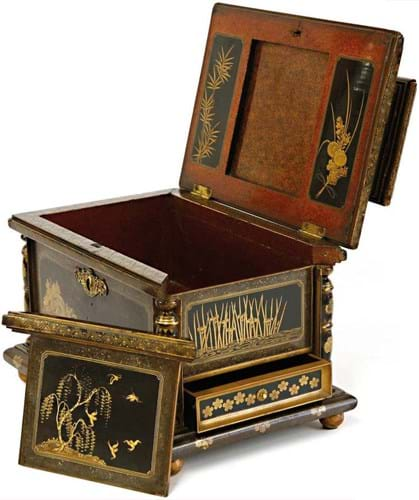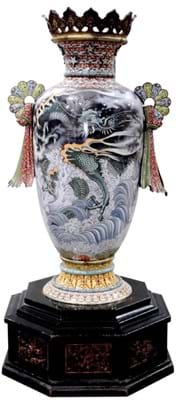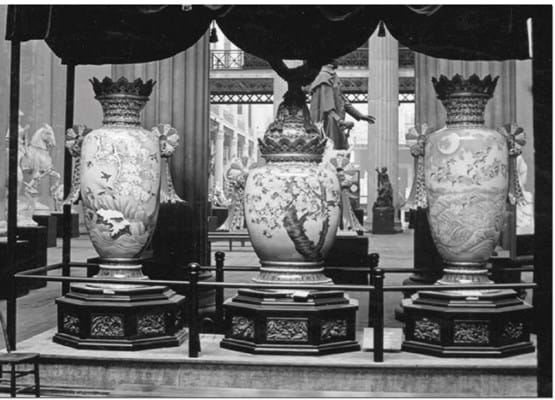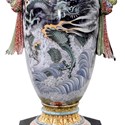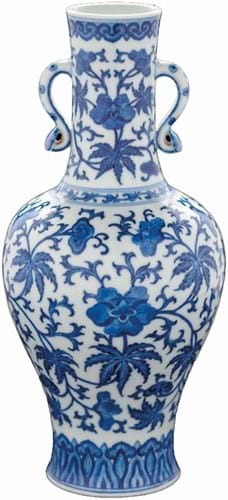
From an attic to £460,000
Exeter saleroom Bearnes Hampton & Littlewood (21% buyer’s premium) sold this 11in (27cm) Qianlong (1735-95) blue and white vase with Ming-style decoration for £460,000 on January 30 (shown above).
It came for sale via a general email enquiry together with a dozen unexceptional objects that had been in attic storage since they were inherited from an aunt. Annie Madeline Glover, a teacher who lived and worked in Shanghai from 1910-22, had returned home with her young son on the P&O steamship Egypt. She settled in Bath.
While no other vase of the same form and decoration has been found, other examples are known in doucai colours. It was in perfect condition save a tiny chip to one ruyi handle terminal.
More than a dozen interested parties registered to bid in the room or on the phone with the hammer price, tendered by an agent in the room, well above an estimate of £20,000-40,000.
Western impact evident
Although the Edo period is characterised as the era of self-imposed semi-isolation after the relative openness of the Momoyama, the limited international trade in Japanese art continued to have a great impact on the West.
This 12in (30cm) casket, offered for sale by Sworders in Stansted Mountfitchet on May 17, was identified by bidders as part of a rare group of early to mid-17th century export wares.
It is decorated in gold hiramaki-e, takamaki-e and nashiji techniques on a black ground in transitional style with pavilions in landscapes, flowers and grasses, and mounted with copper gilt fittings. One sliding side opened to reveal a secret drawer.
In remarkably good condition, it sold online well above estimate to a Hong Kong buyer at £40,000 (plus 23% buyer’s premium).
Censer sensation
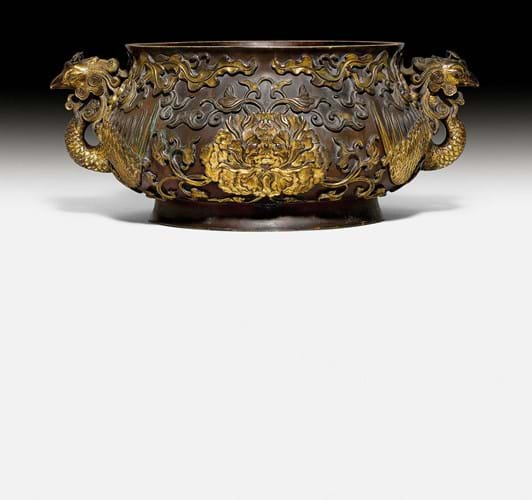
This imperial ‘phoenix and peony’ censer, a fraction short of 2ft (60cm) across and weighing over 22kg, had caused a sensation when previewed at this year’s International Antiques Fair in Hong Kong (May 25-28) in advance of its sale at Koller in Zurich on June 4.
The parcel gilt bronze was being used to hold tennis balls when first seen by valuers last year. It had been in a Swiss collection, by descent from German ancestors, for more than a century. Although it carries a six-character mark for the fifth Ming emperor Xuande (1425-35), it was thought to date from the early years of the Qing dynasty, c.1700.
Estimated at SFr50,000-80,000, it sparked intense phone and room bidding before it was secured by a Chinese collector at SFr4.2m/£3.3m (SFr4.9m including buyer’s premium).
Early starter
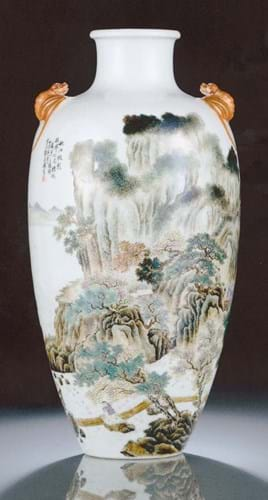
This vase by Republic period decorator Zhang Zhitang offered by Nagel in Salzburg on June 6-7 took €155,000 (£140,000).
The Republic period decorator Zhang Zhitang (1893-1971) from Xingjiang began learning to paint on porcelain when he was just eight. He produced most of his work between 1937-44, before becoming an instructor at the Jiangxi Provincial Pottery College and the Jingdezhen Ceramic Institute.
This 13in (34cm) high vase, with a seal mark and signature corresponding to 1937, is painted with a continuous landscape. Guided at €5000-8000 by Nagel (33% buyer’s premium) in Salzburg on June 6-7, it sold to a US buyer at a punchier €155,000 (£140,000).
From Tipu's personal armoury

This rifle from the personal armoury of Tipu Sultan sold for £60,000 at the Antony Cribb auction in Abingdon, Oxfordshire, on March 26.
A rifle from the personal armoury of Tipu Sultan sold for £60,000 (plus 22% buyer’s premium) at the Antony Cribb auction in Abingdon, Oxfordshire, on March 26.
The magazine-fed flintlock rifle c.1785 with silver mounts and panels of gold-inlaid tiger stripe pattern (bubri) formed part of a cache of Indian arms and works of art from the descendants of Major Thomas Hart, a British East India Company officer who served at the fall of Seringapatam on May 4, 1799.
The gun, and its companion bayonet stored in the butt, was dated AH1200 or 1785AD and further marked with the place of manufacture (the Haydarnagar Armoury) and The devoted servant Sayyid Da’ud. It showed signs of having been damaged in action and may have been collected from the battlefield.
Throne merits its own auction catalogue

A Qianlong three-colour lacquer throne merited a catalogue of its own at Christie’s on May 14 and sold for £5.2m.
A Qianlong (1736-95) three-colour lacquer throne provided the May London series of Asian art sales with its headline moment.
The 3ft 10in (1.15m) wide nine-dragon throne, similar in design, quality and construction to another in the Palace Museum, merited a catalogue of its own at Christie’s on May 14 and an £800,000-1.2m estimate. It was pursued to £5.2m (£6.1m with premium). Perhaps 150 coats of lacquer were applied, then carved, to achieve the three-colour effect that was typically reserved for the imperial household.
It came for sale from a private Asian collection having been acquired in Hong Kong in 1997.
Malaysian Modernist
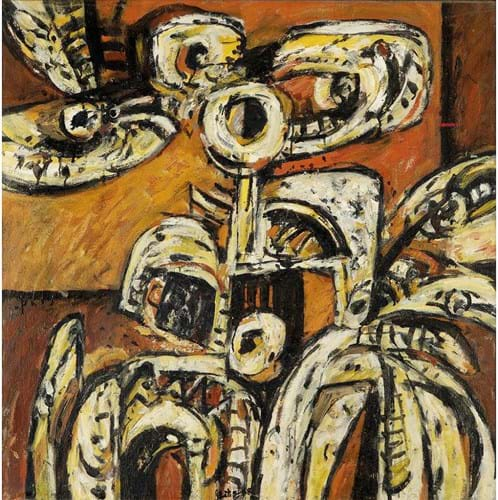
Growth I by Malaysian Modernist painter and poet Abdul Latiff Mohidin sold for an auction record £200,000 at Lyon & Turnbull in London.
Lyon & Turnbull set an auction record for the Malaysian Modernist painter and poet Abdul Latiff Mohidin (b.1938) in London on March 27.
Growth I, signed and dated 1968, had been acquired by the vendor in London in the early 1970s. The 2ft 6in (77cm) square oil dates from the latter part of Mohidin’s so-called Pago Pago period that brought him his first wave of international recognition.
It was hammered down at £200,000 (plus 25% buyer’s premium) against an estimate of £30,000-50,000.
'Lost' monumental vase surfaces for sale
The Khalili Collections revealed it was the buyer of this ‘lost’ monumental Meiji cloisonné vase that surfaced for sale in California in the spring. The 8ft (2.44m) high vase has since been reunited with its pair and a centrepiece, thus re-forming a landmark Japanese garniture last seen together over 120 years ago.
The details of the commission of two huge vases and a centrepiece for Japan’s stand at the 1893 World’s Columbian Exposition in Chicago are well known. Employing an all-star cast of artists and craftsmen and four years in the making, at the time they were dubbed ‘the largest pieces of cloisonné ever made’.
The Khalili Collections, began by the British-Iranian scholar and philanthropist Prof Nasser David Khalili five decades ago, had acquired one vase from the set in the early 1990s in Los Angeles, later purchasing the centrepiece from Japanese collector Hirose Atsushi in early 2000.
The whereabouts of the last vase remained a mystery until it was discovered in one of the San Francisco Bay Area’s oldest restaurants, Spenger’s Fresh Fish Grotto in Berkeley. It had been bought by proprietor Frank Spenger in 1893.
It was offered for sale on February 17 at Clars Auction Gallery of Oakland, California, with an estimate of $30,000-50,000. Despite several areas of damage, it attracted multiple bidders before selling at $110,000 (plus 23% buyer’s premium).
A Chinese Impressionist
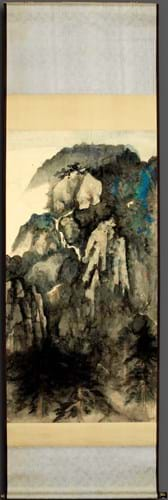
Scroll painting by Zhang Da Qian, The Grand View of Chao Mountain, which took £2.3m when it came for sale at Woolley & Wallis in Salisbury.
Originally known as a guohua (traditionalist) painter, by the 1960s Zhang Da Qian (1899-1983) was also renowned as an Impressionist.
In this 6ft 3in x 3ft 4in (1.91 x 1.01m) scroll painting, The Grand View of Chao Mountain, signed and dated February of the ‘yi si year’ (1968), he used his famous splash ink and colour technique to create a spectacular spring landscape. The title slip is signed by Zeng Ke Duan (1900-76), the calligrapher and University of Hong Kong professor who was Da Qian’s closest friend and often asked to inscribe important works from his oeuvre.
It had been given by the artist to the owner’s father over afternoon tea sometime c.1970-80 and came for sale at Woolley & Wallis in Salisbury from an English collection with a conservative estimate of £100,000-150,000. One of seven phone lines jumped straight in at £500,000 but the winning bid of £2.3m (plus 25/12% buyer’s premium) was tendered in the room by a dealer from China.
Vase is fine example of intricate art
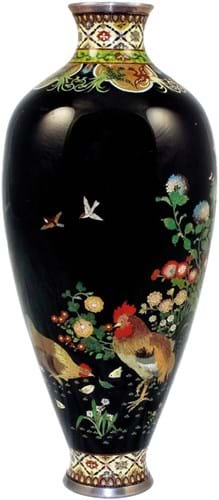
This Meiji period vase by one of the great exponents of the intricate art of cloisonné enamel, Namikawa Yasuyuki, sold for £29,000 at The Canterbury Auction Galleries.
This Meiji period vase by one of the great exponents of the intricate art of cloisonné enamel went back to Japan after its sale at The Canterbury Auction Galleries (24% buyer’s premium inc VAT).
The 7in (18cm) vase from the Kyoto workshop of Namikawa Yasuyuki (1845-1927) was decorated in coloured enamels and varying thicknesses of gold wire with a cockerel and a Pekin chicken among flowers and birds. Signed to the base, it sold to a Japanese collector bidding online via thesaleroom.com for £29,000 on April 10.
The vase, estimated at £4000-6000, had been acquired at some time in the late-19th or early-20th century by Edward John Power (1858-1916), a collector of Oriental items, and it had passed by descent to his great-grandson.
Mass baptism
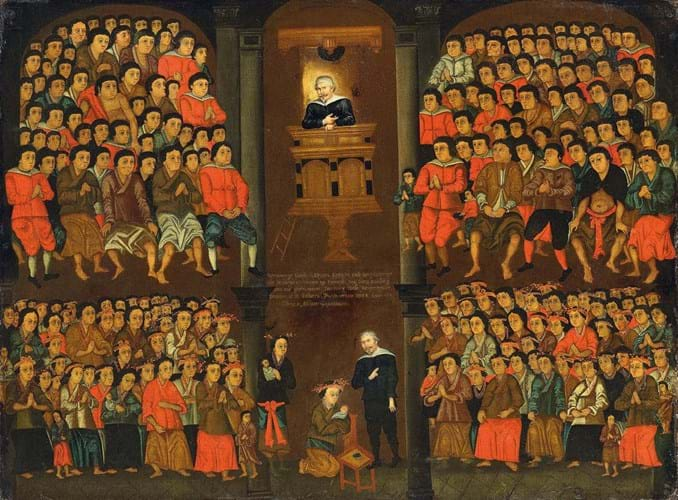
This oil showing the baptism of hundreds of natives in Formosa (present-day Taiwan) made £195,000 when offered by Christie’s in London.
Born in Rotterdam in 1606, Robert Junius was a prominent missionary of the Dutch Reformed Church working in Formosa (present-day Taiwan) between 1629-43. He established churches in at least 29 towns, baptised nearly 6000 adults and translated prayers and psalms into the local dialect.
This 3ft 1in x 4ft 2in (95cm x 1.28m) oil, sold by Christie’s in London in December 2018, shows the baptism of hundreds of natives. Junius appears twice: first in the throes of Christian teaching from a pulpit, then in the midst of a baptism ceremony lower down the picture.
Dated to 1643 – Junius’ last year on the island before returning home – it seems likely it was commissioned by the missionary to commemorate his time in Formosa. It is thought that Dutch artist Adriaen Souter (1628-70) and an anonymous local Chinese artist painted the picture that sold at £195,000 (25/20/13.5% buyer’s premium) against an estimate of £20,000-30,000.
Rare image of a sultan
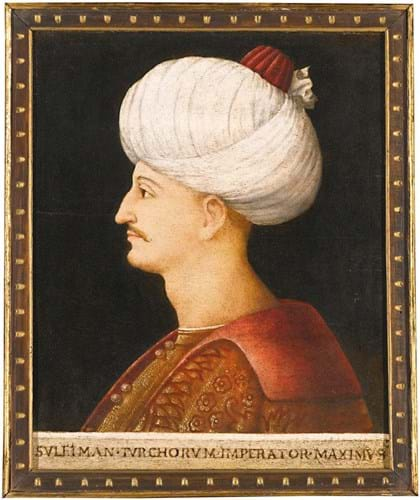
This Venetian oil on panel portrait of the fabled sultan Suleyman the Magnificent painted by a follower of Gentile Bellini c.1520 sold for £4.5m at Sotheby’s.
One of the few images of a 16th century Eastern potentate by a Western artist emerged from a ‘royal collection’ to sell for a multi-estimate sum at Sotheby’s in London on May 1.
This Venetian oil on panel portrait of the fabled sultan Suleyman the Magnificent painted by a follower of Gentile Bellini c.1520 was the subject of a three-way, 10-minute bidding battle ending at £4.5m (estimate £350,000-500,000) plus premium.
It is a famous image. Unlike his great-grandfather, Mehmed II, who invited European artists to the Ottoman court, Suleyman does not seem to have commissioned any portraits. Details of his appearance were conveyed only through sketches created by artists accompanying foreign embassies to the Ottoman court.
This picture – inscribed Turchorum Imperator Maximus – possibly served as the source for later portraits of Suleyman including a Dürer drawing and a print by the lithographer known by the monogram AA. Andrea Gritti (1455-1538), a Constantinople grain merchant and Venetian diplomat, may have commissioned it.
It was formerly in the art collections of retail magnate Samuel Kress, the Italian politician Contini Bonacossi and Count Vittorio Cini at the Castello di Monselice.
Siamese speciality
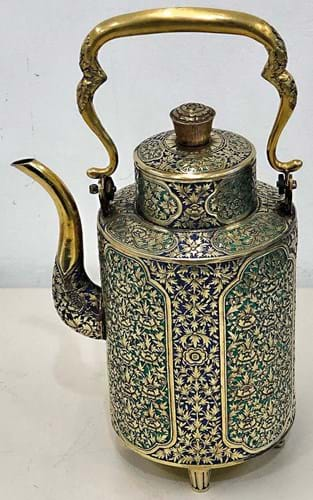
Tea kettle c.1850-60 made in Siam with Niello decoration, which sold for £13,500 at Sutton Hill Farm Country Auctions.
Niello decoration, as practised by Chinese emigre artisans working in Siam, became a speciality of the southern city of Nakhon Si Thammara.
Items of this quality – an octagonal tea kettle c.1850-60 chased with interlocking cotton rosemallow blooms and enamelled in green and blue – were typically commissioned by members of the extended Siamese royal family.
Some of those that made it to the West were presented as diplomatic gifts. This example, offered for sale at Sutton Hill Farm Country Auctions of Broughton Astley in Leicestershire on July 19, sold to a Bangkok buyer for £13,500 (plus 17.5% buyer’s premium).
Sword surprise result
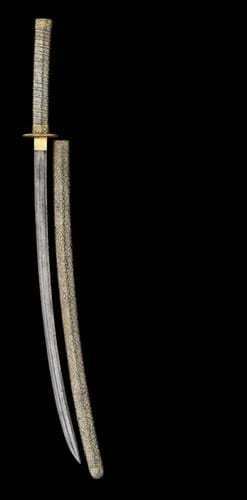
This 19th century Siamese niello and silver-gilt mounted sword sold for an unexpected £42,000 at a Thomas Del Mar auction.
This 19th century Siamese niello and silver-gilt mounted sword sold for an unexpected £42,000 at the Thomas Del Mar (24% buyer’s premium) auction in London on December 5. It is made in the Japanese taste with a niello-decorated silver hilt and scabbard and a circular brass guard in imitation of a tsuba.
The catalogue noted that similarly decorated swords were used as diplomatic gifts including one from King Mongkut to US President Buchanan in 1861.
Missionaries and clockmaking

The Gros & Delettrez auction in Paris on June 6 featured this Qing dynasty musical automaton which sold for €1.22m (£1.09m).
Imperial Chinese fascination with elaborate Western clocks and other works of art provided a steady stream of employment to European missionaries with knowledge of Western clockmaking.
Some of them went to the Chinese court to work alongside local craftsmen in the imperial workshops, producing pieces that were an amalgam of Oriental and Occidental ingenuity and technical prowess.
The sale held by Gros & Delettrez (28% buyer’s premium) in Paris on June 6 featured this Qing dynasty musical automaton standing an impressive 5ft 6in (1.69m) high.
The cloisonné jardinière engraved with dragons and other motifs houses a cylinder musical movement, a clock and an automaton mechanism activated via a pull string that causes the lotus flowers to move. It eclipsed its €30,000-50,000 estimate to make a hammer price of €1.22m (£1.09m).
Fresh technical approach
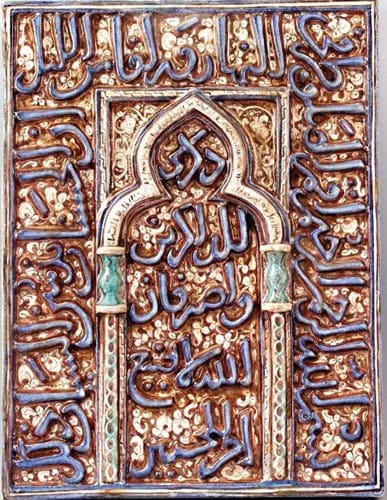
This large Persian lustre tile dating from c.1300 sold for £95,000 at John Nicholson’s saleroom in Haslemere.
This large Persian lustre tile dating from c.1300 sold for £95,000 at John Nicholson’s (25% buyer’s premium) saleroom in Haslemere, Surrey, on May 23. It went on the phone to a private collector in London competing against a dealer.
Lustre wares and large architectural elements played a prominent role in the revival of the ceramic industry in Persia after the hiatus that followed the invasion of the Mongol hordes in the 1220s. Pottery from the Ilkhanid period (1256-1353) brought both a fresh technical approach and a new design vocabulary.
This tile, measuring 19in (48cm) high x 15in (37cm) wide with a thickness of around 2in (5cm), probably formed part of a central section from a monumental Kashan mihrab – the niche in the wall of a mosque that indicates the direction of Mecca.
It is moulded in relief with verses from the Qur’an to a foliate ground and enhanced with cobalt blue and turquoise.


